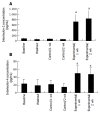Consumption of purple sweet potato leaves modulates human immune response: T-lymphocyte functions, lytic activity of natural killer cell and antibody production
- PMID: 16270384
- PMCID: PMC4479675
- DOI: 10.3748/wjg.v11.i37.5777
Consumption of purple sweet potato leaves modulates human immune response: T-lymphocyte functions, lytic activity of natural killer cell and antibody production
Abstract
Aim: To study the immunological effects of physiological doses of purple sweet potato leaves (PSPL).
Methods: The randomized crossover study (two periods, each lasting for 2 wk) involved 16 healthy non-smoking adults of normal weight. The 6-wk study consisted of a run-in (wk 1) PSPL diet (daily consumption of 200 g PSPL) or a control diet (low polyphenols, with the amount of carotenoids adjusted to the same level as that of PSPL) (wk 2-3), washout diet (wk 4), and switched diet (wk 5-6). Fasting blood was collected weekly in the morning. T-lymphocyte function was assessed via the proliferation and secretion of immunoreactive cytokines. Salivary IgA secretion and the specific cytotoxic activities of cytotoxic T lymphocytes and natural killer (NK) cells were determined.
Results: The plasma beta-carotene level increased with time in both groups, while the plasma polyphenol level decreased in the control group, and no significant difference was detected between the two groups. Although plasma polyphenol levels did not significantly increase in the PSPL group at the end of the study, they were significantly elevated in urine. PSPL consumption produced a significant increase in proliferation responsiveness of peripheral blood mononuclear cells (PBMC) and their secretion of immunoreactive IL-2 and IL-4. As well, lytic activity in NK cells was elevated in a time-dependent fashion. Salivary IgA secretion significantly decreased in control group after 2 wk, and returned to baseline following dietary switch to PSPL.
Conclusion: Consumption of PSPL modulates various immune functions including increased proliferation responsiveness of PBMC, secretion of cytokines IL-2 and IL-4, and the lytic activity of NK cells. The responsible determinants of PSPL remain to be elucidated, as does the biological significance of the present observations.
Figures




Similar articles
-
Effect of purple sweet potato leaves consumption on the modulation of the immune response in basketball players during the training period.Asia Pac J Clin Nutr. 2007;16(4):609-15. Asia Pac J Clin Nutr. 2007. PMID: 18042519 Clinical Trial.
-
Consumption of purple sweet potato leaves decreases lipid peroxidation and DNA damage in humans.Asia Pac J Clin Nutr. 2008;17(3):408-14. Asia Pac J Clin Nutr. 2008. PMID: 18818160 Clinical Trial.
-
Constituents in purple sweet potato leaves inhibit in vitro angiogenesis with opposite effects ex vivo.Nutrition. 2011 Nov-Dec;27(11-12):1177-82. doi: 10.1016/j.nut.2011.01.005. Epub 2011 Jul 18. Nutrition. 2011. PMID: 21763106 Clinical Trial.
-
The regulation and biological activity of interleukin 12.Leuk Lymphoma. 1998 May;29(5-6):427-38. doi: 10.3109/10428199809050903. Leuk Lymphoma. 1998. PMID: 9643557 Review.
-
Immunology in drug research.Prog Drug Res. 1984;28:233-72. doi: 10.1007/978-3-0348-7118-1_7. Prog Drug Res. 1984. PMID: 6091176 Review. No abstract available.
Cited by
-
Bioactive Compounds, Antioxidants, and Health Benefits of Sweet Potato Leaves.Molecules. 2021 Mar 24;26(7):1820. doi: 10.3390/molecules26071820. Molecules. 2021. PMID: 33804903 Free PMC article. Review.
-
Sweet Potato (Ipomoea batatas L.) Phenotypes: From Agroindustry to Health Effects.Foods. 2022 Apr 6;11(7):1058. doi: 10.3390/foods11071058. Foods. 2022. PMID: 35407143 Free PMC article. Review.
-
The cardioprotective power of leaves.Arch Med Sci. 2015 Aug 12;11(4):819-39. doi: 10.5114/aoms.2015.53303. Epub 2015 Aug 11. Arch Med Sci. 2015. PMID: 26322095 Free PMC article.
-
Pelargonidin-3-O-glucoside and its metabolites have modest anti-inflammatory effects in human whole blood cultures.Nutr Res. 2017 Oct;46:88-95. doi: 10.1016/j.nutres.2017.09.006. Epub 2017 Sep 21. Nutr Res. 2017. PMID: 29132841 Free PMC article.
-
Diets containing traditional and novel green leafy vegetables improve liver fatty acid profiles of spontaneously hypertensive rats.Lipids Health Dis. 2013 Nov 5;12:168. doi: 10.1186/1476-511X-12-168. Lipids Health Dis. 2013. PMID: 24192144 Free PMC article.
References
-
- Block G, Patterson B, Subar A. Fruit, vegetables, and cancer prevention: a review of the epidemiological evidence. Nutr Cancer. 1992;18:1–29. - PubMed
-
- Surh Y. Molecular mechanisms of chemopreventive effects of selected dietary and medicinal phenolic substances. Mutat Res. 1999;428:305–327. - PubMed
-
- Rice-Evans CA, Miller NJ, Paganga G. Structure-antioxidant activity relationships of flavonoids and phenolic acids. Free Radic Biol Med. 1996;20:933–956. - PubMed
-
- Middleton E. Effect of plant flavonoids on immune and inflammatory cell function. Adv Exp Med Biol. 1998;439:175–182. - PubMed
-
- Duthie SJ, Johnson W, Dobson VL. The effect of dietary flavonoids on DNA damage (strand breaks and oxidised pyrimdines) and growth in human cells. Mutat Res. 1997;390:141–151. - PubMed
Publication types
MeSH terms
Substances
LinkOut - more resources
Full Text Sources
Other Literature Sources
Research Materials
Miscellaneous

